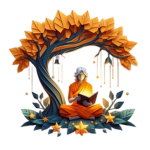The oldwisdom of Hinduism itself gives the individual's conception about consciousness a view that stretches right beyond the personal level. One of these concepts, the one I call "Atharvanic Anya-Chitta" or "Other-Mind," emerges from the Atharvaveda and hints at a deeper grasp of interconnected consciousness that resonates with both ancient wisdom and today's spiritual seekers.
The Roots in Atharvaveda
The Atharvaveda is the unlike and generally forgotten fourth Veda, and its verses present beautiful treatises on the inter-parallel nature of consciousness. Though the term "Anya-Chitta" does not feature in it, the text contains many mantras that indicate how individual minds (chitta) share an underlying unified field of consciousness.
Thus Atharvaveda 6.94.2 speaks: "May all beings look at me with the eye of friendship. May I look at all beings with the eye of friendship. May we look at one another with the eye of friendship." This suggests profound interconnection in sharing perception and emotional states across seemingly separate consciousnesses.
Similarly, the following verse of Atharvaveda 19.62.1 stipulates: "Heaven is my father, my progenitor; my mother is this great Earth. Within the two bowl-halves [of heaven and earth] is placed the womb; here the Father placed the daughter's embryo." This poetic imagery expresses how individual consciousness exists within a larger matrix of universal awareness.
Beyond Individual Awareness
Anya-Chitta challenges the general perception that consciousness is meant only for individual minds. It implies, rather, that:
1. Thoughts of an individual go beyond to affect and be affected by thoughts of others through some unseen electrical connections.
2. Consciousness flows like a stream between apparently disparate entities.
3. One penetrates into such deep meditation that the separation of the mind turns out to be mere fantasy.
As the Katha Upanishad (2.2.9-10) bases itself on Atharvanic principles, it says- "What is here is there; what is there is here. He who sees any difference between here and there, between this and that, goes from death to death." Such a deep statement implies that the very notion of separation, mental separation included, is fundamentally illusive and takes a person into the valley of spiritual limitation.
Modern Applications for Spiritual Seekers
Understanding Anya-Chitta would apply practically to those wanting to adopt Hindu spirituality.
Therefore, first, meditation tradition has taught training broaden awareness beyond boundaries of the individual. The practitioner is to feel thoughts and emotions of others not as separate phenomena but as movements within a shared field of consciousness.
Second, on a greater wavelength, ahimsa, or non-violence, goes deeper: harming others in the mental realm through negative thoughts creates disturbances in the shared consciousness that ultimately affect oneself.
Third: "When the mind is purified by the practice of self-inquiry and abidance in the Self, it becomes aware of its non-separation from the universal consciousness," as it has been recorded in Yoga Vasistha (3.55.7). This text has much in it from the Atharvanic principles, and thus the spiritual practice unveils the inborn connection we have with one another.
Anya-Chitta Experience
One of the Atharvanas concepts synthesized by the Mandukya Upanishad defines four states of consciousness, the fourth being Turiya, in which transcendence becomes manifested between individual awareness and unveiling of the unified field of consciousness where all minds participate.
Through such practices as dhyana (meditation), one starts experiencing stretches of awareness that surpass the isolated boundaries of the individual. It's not a theoretical exercise, but it can be tested in live experience where the false separations between "my mind" and "the minds of others" dissolve into a flowing unity of awareness.
Bhagavad Gita affirms: "One who sees the Supreme Lord existing equally in all beings, not perishing when they perish, truly sees." This seeing beyond individual minds to the unifying consciousness represents the essence of Atharvanic Anya-Chitta.
For the genuine seeker who wants to imbibe Hindu spirituality, such understanding offers not only a philosophical proposition but also a very experiential transformative pathway to flesh out the ultimate reality that binds us all together in one universal awareness.

.png)
0 Comments